Partial Contact of a Rigid Multisinusoidal Wavy Surface with an Elastic Half-Plane
Abstract
The interaction effects, arising at partial contact of rigid multisinusoidal wavy surface with an elastic half-plane, are considered in the assumption of continuous contact configuration. The analytical exact and asymptotic solutions for periodic and nonperiodic contact problems for wavy indenters are derived. Continuous contact configuration, appearing at small ratios of amplitude to wavelength for cosine harmonics, leads to continuous oscillatory contact pressure distribution and oscillatory relations between mean pressure and a contact length. Comparison of periodic and nonperiodic solutions shows that long-range elastic interaction between asperities does not depend on a number of cosine wavelengths.
1. Introduction
Real rough surfaces are three-dimensional and multiscale. Besides fully random rough surfaces [1] there are natural and technical surfaces, having quasiregular character of asperities on several scales (e.g., periodic anisotropic waviness) [2]. For these surfaces the geometric model of two-dimensional wavy 2D profile can be applied as a first approximation. Also, in some fields of engineering, the wavy textures of different shapes are used (e.g., in optical devices and MEMS) [3]. Considering the elastic contact processes, occurring for soft materials (polymers and biological materials), the various analytical methods of plane elasticity can be applied. In the case of full contact, when the gap between surfaces is filled, the problem can be easily solved by Fourier transform method [4]. However, the very high applied pressure is required to reach the full contact condition even for soft materials, so partial contact is the more often case. Partial contact between wavy surfaces is a problem with mixed boundary conditions, which was solved by different mathematical techniques.
The classic periodic contact problem in plane elasticity is an old problem [5, 6]. Concerning geometry of a wavy surface, considered in the previous studies, the cosine [7, 8], the squared cosine [9], and evenly spaced parabolic or wedge stamps [10, 11] were generally used. The analytical solution of the pointed problem for those surface geometries was obtained by different methods. For the cosine profile they are complex stress function [7], dual series equation [12], intercontact gaps method [13], variable transform method [11], and fracture mechanics approach [14].
Taking into account simple wavy geometry (cosine or squared cosine) the contact problems with more complicated boundary conditions were studied: sliding problem with friction [15, 16], with a fluid lubricant [17], with a partial slip [11, 18], with adhesion and sliding friction [19], for viscoelastic material [20], for Winkler model of viscoelastic material and adhesion [21], for elastic layer with presence of friction and wear [22], and dynamic problem for anisotropic half-plane [23].
The normal elastic problem for a two-dimensional nonsinusoidal wavy profile, where a shape of a waveform is controlled by a parameter, was solved analytically [24]. It was established that the pressure distribution is highly sensitive to the shape of a wavy surface, especially at large loads.
The presence of several scales of a wavy surface leads in general to a multizone periodic contact problem [9, 25]. The asymptotic approximate solution for initial contact for a two-scale wavy surface was obtained [24]. It was shown that even for initial contact the interplay between harmonics exists. Considering the problem in a wide range of applied loads it is necessary to use a numerical procedure. Such studies were performed by different techniques: Fourier series and cotangent transform [26], full contact solution and iteration procedure [27], FFT and variational principle [28], nonlinear boundary integral equation [29], boundary element method [30], and finite element method [31]. The equations for internal stresses for sinusoidal pressure distributions in 2D and 3D cases were also derived [32]. The results of these studies show that multiscale character of a wavy surface at partial contact with an elastic half-plane leads to multiple peaks of high pressure. The pressure distribution is jagged in this case, and a load-area dependence tends to proportionality at large number of harmonics [31].
In cases, considered in the previous studies, the contact was partial at all scales, because the amplitudes of different harmonics were comparable. This situation leads to a discontinuous (discrete) contact configuration [33]. Besides numerical methods, the other way to solve these problems is usage of multiasperity contact models. Based on the nature of the surfaces models can be deterministic and statistical. Review of statistical models, based on individual asperity contact, in comparison with the Persson’s model and numerical simulations, is performed in [34]. For the nearly complete contact case, when the ratio of the real area of contact to the nominal contact area approaches unity, the statistical model, based on fracture mechanics approach, was developed [35]. For deterministic multiscale surfaces, (e.g., multisinusoidal self-affine surfaces), the Archard’s approach was successfully implemented [36, 37].
However, if at a certain scale amplitude of the cosine harmonic is much smaller than its period, full contact on this scale occurs, and a continuous oscillating pressure distribution on a larger scale will be observed [33, 38]. For distinguishing these cases the Johnson parameter, coupling an amplitude, a period of cosine harmonic, and a reduced modulus of elasticity with Hertzian pressure at the point, where maximum pressure occurs, is used [33]. In the present study the continuous contact configuration, observed at small amplitudes of subsequent cosine harmonics, is analyzed analytically for periodic and nonperiodic multisinusoidal rigid indenters in contact with an elastic half-plane.
2. Problem Formulation and Assumptions
The general scheme of the problem on the single period λ1 for one, two, and three cosine harmonics profile is presented in Figure 1.
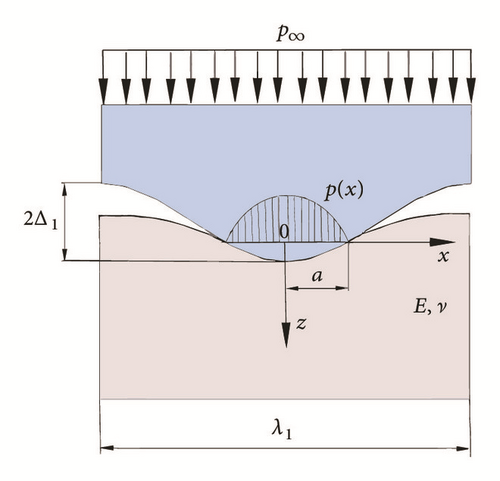
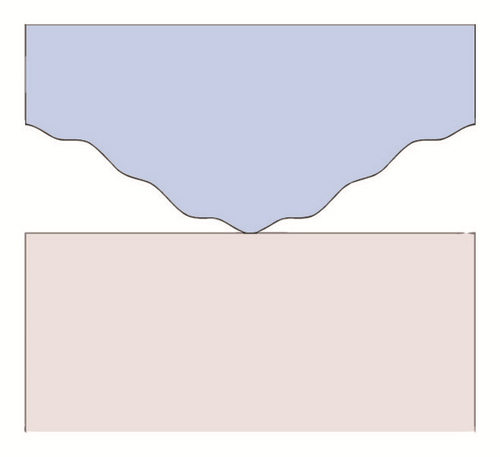
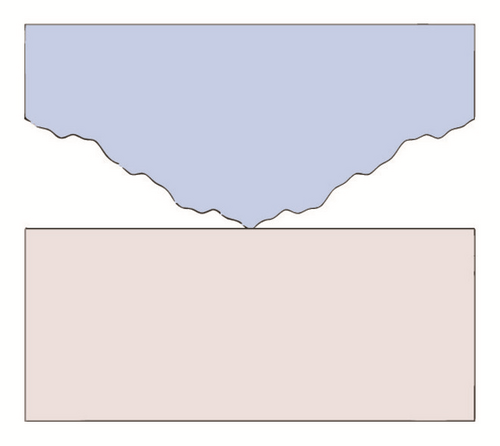
The wavy surface is assumed to be rigid, and the elastic half-plane is an isotropic semi-infinite body with two elastic constants: Young’s modulus E and Poisson’s coefficient ν. Also the plain strain condition is applied. The amplitudes of cosine harmonics are much smaller than their periods (Δi ≪ λi, where i = 1, 2 … N is a harmonic sequence number). This condition makes it possible to apply the linear elasticity theory. The Johnson parameter χ = πEΔi/2phλi (where ph = 2p∞λi/πa, p∞ is an applied mean pressure, and a is a contact half-width) should be χ < 1 [33] for preserving the continuous contact configuration.
where h(x) is an initial gap between surfaces, and p(x) is a contact pressure distribution.
where δ is a contact approach and ni = λ1/λi. In the given formulation of the problem .
where N is a number of wavelengths and pi(x) is a component of pressure distribution for the ith wavelength.
where C is a constant depending on the selected datum point and are the surface vertical displacements for the ith wavelength.
3. Solutions of the Problem for the ith Harmonic
3.1. Solution for a Periodic Wavy Surface
where Tj – is a Chebyshev polynomial of the first kind with a degree j [39].
The total pressure distribution is obtained by using equation (4). For numerical calculations it is necessary to hold finite terms of the infinite series in equation (10). For the arbitrary period, the variables x and a in equations (10) and (12) should be multiplied on 2π/λ1. The mean pressure p∞i and the vertical displacements can be obtained using numerical integration in equations (5) and (6). The maximum pressure is determined as the pressure at the point x = 0.
3.2. Solution for a Wavy Rigid Nonperiodic Indenter
where Jj(t) is the Bessel function of the first kind of the integer order j and the argument t [39].
where sign ∑/ identifies the sum of terms with odd j only.
where sign ∑/ identifies the sum of terms with odd j only.
4. Results and Discussion
The evolution of the dimensionless contact pressure distribution p(x)/p ∗ (p ∗ = πEΔ1/λ1) for a periodic problem (equations ((6) and (10)-(12)), λ1 = 2π, Δ1 = 0.5) for various contact lengths (2a) and two different profiles f(x) is shown in Figure 2.
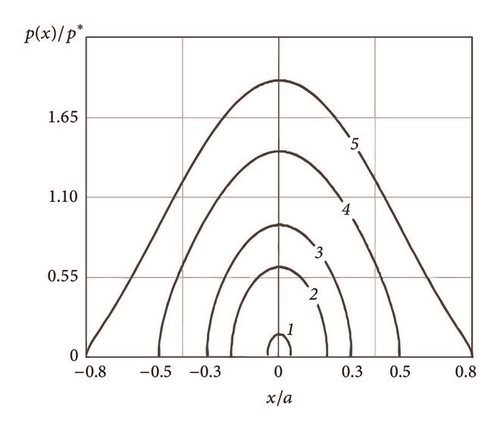
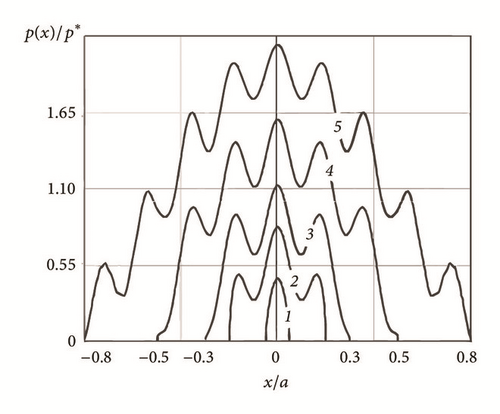
The exact (solid lines, equation (14)) and the approximate (dotted lines, equation (20)) graphs of the dimensionless contact pressure p(x)/p ∗ for different profiles of a nonperiodic wavy indenter are shown in Figure 3.
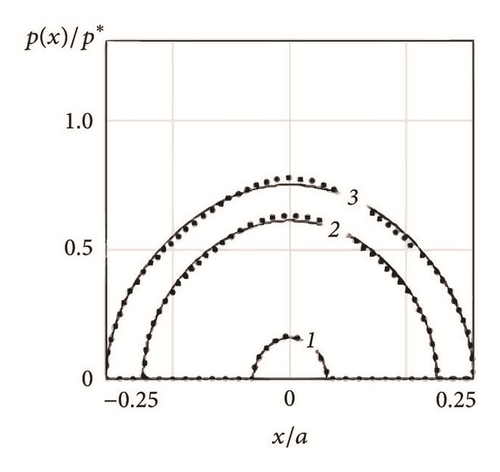
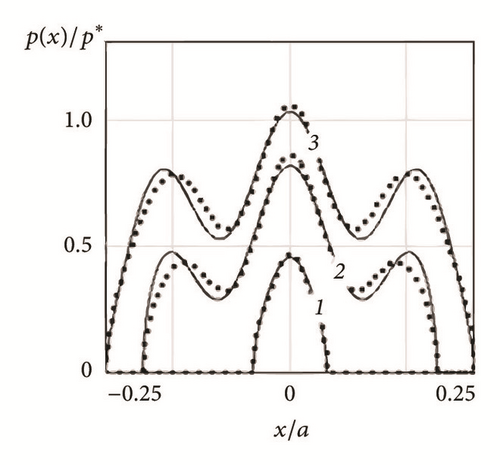
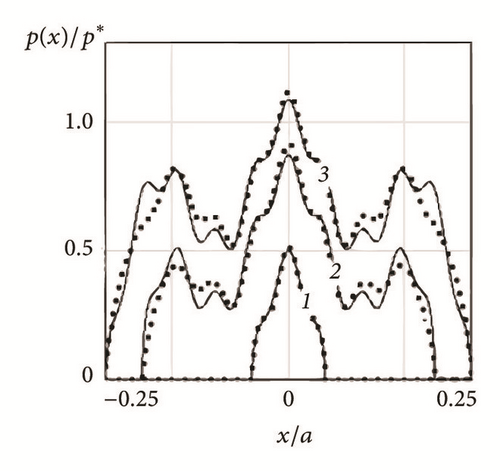
Figures 2 and 3 illustrate that, with increasing the number of harmonics, the pressure distribution becomes more complex and the maximum pressure grows significantly. For a single-scale periodic cosine profile (Figure 2(a)) the Westergaard’s solution is recovered. For a single-scale nonperiodic indenter (Figure 3(a)) the Hertz solution is observed, as the cosine function is very close to the quadratic parabola. Thereby, the distributions, presented in Figures 3(b) and 3(c), correspond to wavy cylinder problem at small waviness [38]. Comparison of the exact and the approximate values of pressure for a single indenter (Figure 3) shows that equation (20) satisfactorily describes the behavior of the pressure distribution.
Comparing the periodic and the nonperiodic solutions the elastic interaction effect is of interest. The mean pressure – contact length curves for two profiles, calculated from periodic and nonperiodic solutions, are presented in Figure 4.
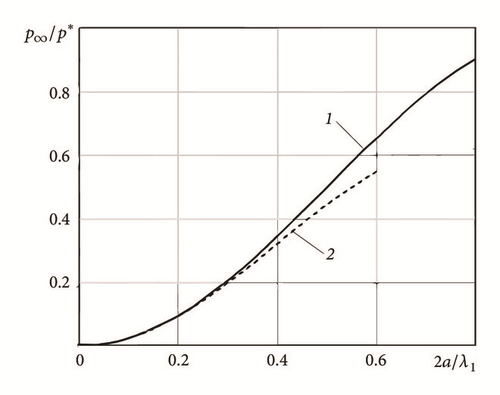
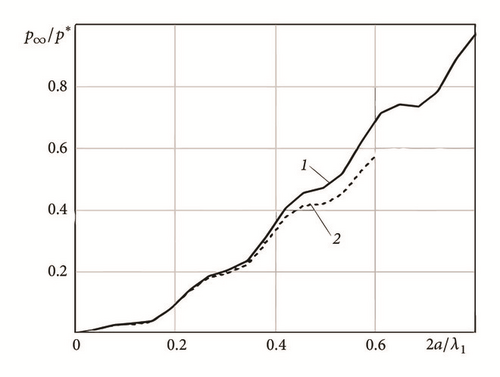
Figure 4 shows that, at small contact lengths (2a < 0.25λ1), the solutions are close. The piece of graphs agreement does not depend on profile geometry. With increase of load the periodic solution gives the smaller contact length due to elastic interaction on the largest scale. For the profile with two cosine harmonics and continuous contact configuration, presented in this study, the oscillations of mean pressure – contact length curves are observed (Figure 4(b)). Curves in Figure 4(a) correspond to Westergaard’s (curve 1) and Hertz (curve 2) solutions, recovered for profile with one wavelength.
Graphs of the mean and the maximum pressures versus contact length on the interval 2a < 0.25λ1 for different profiles of a wavy nonperiodic indenter are shown in Figure 5.
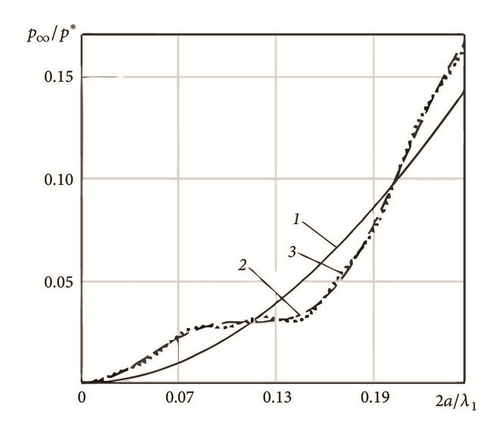
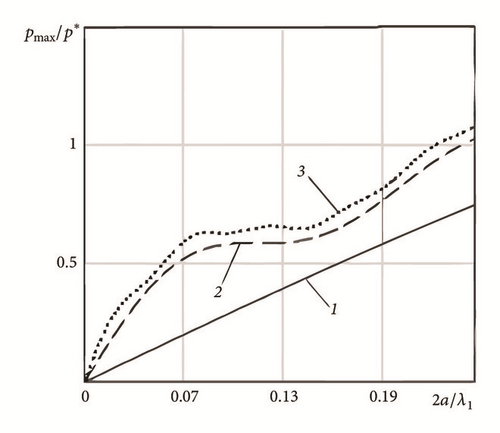
Figure 5 shows that the maximum pressure depends on profile geometry stronger than the mean pressure. However, adding the third harmonic leads to insignificant change of the graphs character. Continuous contact configuration at the presence of several cosine wavelengths leads to oscillatory character of the mean and the maximum pressure graphs. Combining these two graphs numerically one can obtain the dependence of peak pressure from mean pressure (Figure 6).
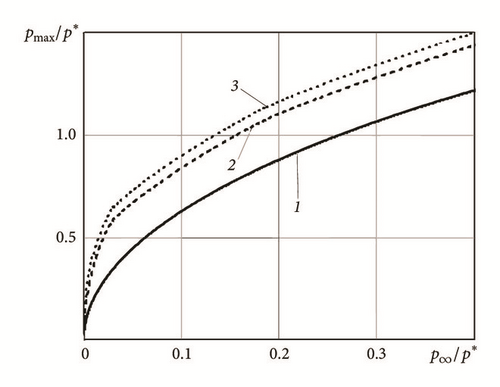
Figure 6 shows that dependences of the maximum pressure from the mean pressure are not oscillatory for the profiles with two and three wavelengths, and additional cosine harmonics change the graph considerably in value but not in character. This statement can be useful in the analysis of contact surfaces fracture processes [33].
5. Conclusions
The continuous contact configuration is one of the two possible configurations, arising at indentation of a multisinusoidal 2D wavy surface into an elastic half-plane. This configuration leads to continuous oscillatory contact pressure distribution. Comparison of the derived periodic and nonperiodic solutions shows that the long-range elastic interaction between asperities does not depend on a number of cosine wavelengths and can be neglected at small loads (contact lengths) for arbitrary wavy profile geometry. The assumption of neglecting the long-range periodicity leads to exact equations for determining the remote and the maximum pressures from the contact length, described by oscillatory functions. However, the dependences of the maximum pressure from the mean pressure are not oscillatory for the profiles with two and three wavelengths and resemble those for a simple cosine profile of indenter. The influence of the additional cosine harmonics on the maximum pressure is significantly larger than on the mean pressure for the same contact zone length. The derived equations can be used at the analysis of contact characteristics of deterministic profiles of arbitrary geometry and also at the validation of more complex numerical models of rough surfaces contact.
Conflicts of Interest
The author declares that there are no conflicts of interest regarding the publication of this paper.
Acknowledgments
The research was supported by RSF (project no. 14-29-00198).
Appendix
Derivation of Contact Pressure Distribution for the Periodic Problem
where Un is a Chebyshev polynomial of a second kind with a degree ni.
where Tj is a Chebyshev polynomial of the first kind with a degree j [39].
Open Research
Data Availability
No data were used to support this study.




